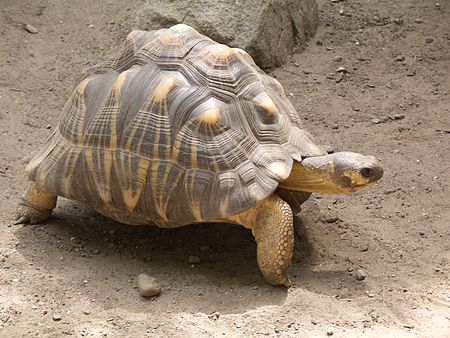Type the name of the breed you're looking for below
[wpdreams_ajaxsearchlite] Don't see the breed your're looking for? Click here and let us know!
Radiated Tortoise
| Place of Origin and Range | Radiated tortoises occur naturally only in the extreme southern and southwestern part of the island of Madagascar. They have also been introduced to the nearby island of Reunion. They prefer dry regions of brush, thorn (Diderae) forests, and woodlands of southern Madagascar. |
| Description | This tortoise has the basic "tortoise" body shape, which consists of the high-domed carapace, a blunt head, and elephantine feet. The legs, feet, and head are yellow except for a variably sized black patch on top of the head. The carapace of the radiated tortoise is brilliantly marked with yellow lines radiating from the centre of each dark plate of the shell, hence its name. This "star" pattern is more finely detailed and intricate than the normal pattern of other star-patterned tortoise species, of India. The radiated tortoise is also larger, and the scutes of the carapace are smooth, and not raised up into a bumpy, pyramidal shape as is commonly seen in the latter species. There is slight sexual dimorphism. Compared to females, male radiated tortoises usually have longer tails and the notches beneath their tails are more noticeable. |
| Morph Patterns Available | No |
| Adult Size | Can grow up to 12 in (31 cm) |
| Accommodation | Arid Rocky savannah, dry forest habitat. To avoid injuries anchor any rocks in the vivarium before you add the substrate. You will want to include a large dish for bathing and soaking in to improve shedding. Always include a day basking spot at 80'F(27'C). Along with multiple hides. Minimum 2 x 8 feet for an adult. |
| Lifespan | Can live 10+ years |
| Feeding / Diet | As the radiated tortoises are herbivores, grazing constitutes 80-90% of their diets, while they also eat fruits and succulent plants. |
| Other Considerations | These tortoises are, however, endangered, mainly because of the destruction of their habitat by humans and because of poaching. Watch for theses health concerns carefully with your tortoise. Vitamin A Deficiency: Vitamin A is an important nutrient for your tortoise’s health. It is found in his diet in the form of leafy green, orange or yellow vegetables, liver, and fish. If your tortoise is not getting enough Vitamin A, he can suffer serious health problems. Always check to make sure that your tortoise does not have swollen eyelids, as this is the main sign of a Vitamin A deficiency. Also, check for weight loss, nasal discharge and infected skin. Any of these symptoms could point to a deficiency. If you think your tortoise may not be getting enough Vitamin A, you should take him to the veterinarian to get a firm diagnosis. Shell Problems: Your tortoise's shell is very important to his overall health. There are many potential problems that could occur, so you should be on the lookout at all times. Respiratory Disease: Respiratory infections have symptoms similar to vitamin A deficiency, including swollen eyelids and runny nose, so you should take your tortoise to the veterinarian to get a proper diagnosis if you suspect either. More serious infections will be characterized by breathing through the mouth, mucus in the mouth, and wheezing. Always make sure your tortoise’s environment has the proper amount of humidity, as this will help prevent respiratory problems. |



